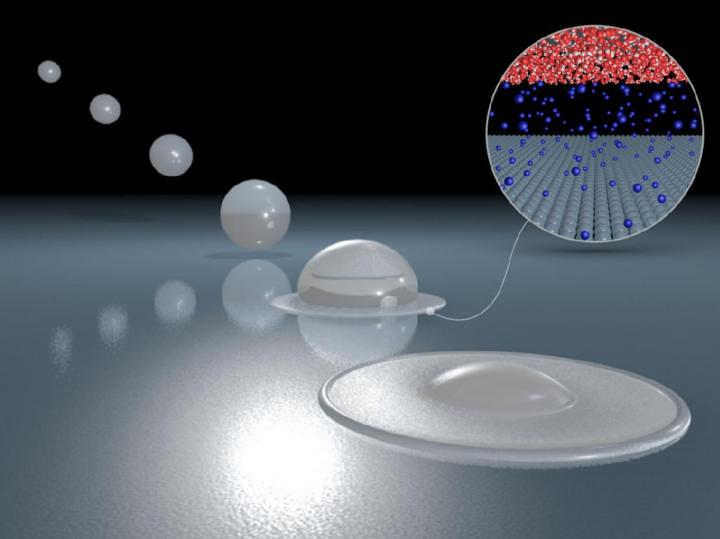Explained: Why water droplets 'bounce off the walls'

An image showing the water drop bounce Credit: University of Warwick Usage Restrictions: Only to be use din conjunction with this story
University of Warwick researchers can now explain why some water droplets bounce like a beach ball off surfaces, without ever actually touching them. Now the design and engineering of future droplet technologies can be made more precise and efficient.
Collisions between liquid drops and surfaces, or other drops, happen all the time. For example, small water drops in clouds collide with each other to form larger drops, which can eventually fall and impact on a solid, like your car windscreen.
Drops can behave differently after the point of collision, some make a splash, some coat the surface cleanly, and some can even bounce like a beach ball.
In the article, published today in Physical Review Letters, researchers from the University of Warwick have found an explanation for experimental observations that some droplets bounce.
Remarkably, the fate of the drop is determined by the behaviour of a tiny cushion of air whose height can reach the scale of nanometres. To get a sense of scale, think of something the size of the moon bouncing from a garden trampoline.
Even if the surface is perfectly smooth, like in laboratory conditions, an affinity between drop molecules and the wall molecules (known as van der Waals attraction), will mean that in most cases the drop will be pinched down onto the surface, preventing it from bouncing.
The research reveals, through highly detailed numerical simulations, that for a droplet to bounce the speed of collision must be just right. Too fast, and the momentum of the drop flattens the air cushion too thinly. Too slow, and it gives the van der Waals attraction time to take hold. At the perfect speed, though, the drop can perform a clean bounce, like a high jumper just clearing the bar.
Professor Duncan Lockerby from the School of Engineering at the University of Warwick comments:
“Drop collision is integral to technology we rely upon today, for example, in inkjet printing and internal combustion engines. Understanding better what happens to colliding droplets can also help the development of emerging technologies, such as 3D printing in metal, as their accuracy and efficiency will ultimately depend on what happens to drops post collision.”
Dr James Sprittles from the Mathematics Institute at the University of Warwick adds:
“Importantly, the air cushion is so thin that molecules will often never encounter one another when crossing it, akin to the emptiness of outer space, and conventional theories fail to account for this. The new modelling approach we've developed will now have applications to droplet-based phenomena ranging from cloud physics for climate science through to spray cooling for next generation electronics.”
###
NOTES TO EDITORS
High-res images available at: https:/
The paper 'Bouncing off the walls: the influence of gas-kinetic and van der Waals effects in drop impact' has been published in Physical Review Letters and is available to view at: https:/
DOI: 10.1103/PhysRevLett.124.084501
The research is supported by grants from the Leverhulme Trust and the Engineering and Physical Sciences Research Council (EP/N016602/1, EP/P020887/1 & EP/P031684/1).
The University of Warwick's Mathematics Institute was ranked 3rd in the UK by the 2014 REF (Research Excellence Framework) – with more than 90% of research activity assessed as either internationally excellent or world leading. The research environment at Warwick is rated by REF 2014 as the very best in the UK for mathematical sciences (achieving the maximum possible score of 100% at 4*).
About the School of Engineering: https:/
FOR FURTHER INFORMATION PLEASE CONTACT:
Alice Scott
Media Relations Manager – Science
University of Warwick
Tel: +44 (0) 2476 574 255 or +44 (0)7920531221
E-mail: alice.j.scott@warwick.ac.uk
Media Contact
All latest news from the category: Physics and Astronomy
This area deals with the fundamental laws and building blocks of nature and how they interact, the properties and the behavior of matter, and research into space and time and their structures.
innovations-report provides in-depth reports and articles on subjects such as astrophysics, laser technologies, nuclear, quantum, particle and solid-state physics, nanotechnologies, planetary research and findings (Mars, Venus) and developments related to the Hubble Telescope.
Newest articles

NASA: Mystery of life’s handedness deepens
The mystery of why life uses molecules with specific orientations has deepened with a NASA-funded discovery that RNA — a key molecule thought to have potentially held the instructions for…

What are the effects of historic lithium mining on water quality?
Study reveals low levels of common contaminants but high levels of other elements in waters associated with an abandoned lithium mine. Lithium ore and mining waste from a historic lithium…

Quantum-inspired design boosts efficiency of heat-to-electricity conversion
Rice engineers take unconventional route to improving thermophotovoltaic systems. Researchers at Rice University have found a new way to improve a key element of thermophotovoltaic (TPV) systems, which convert heat…



